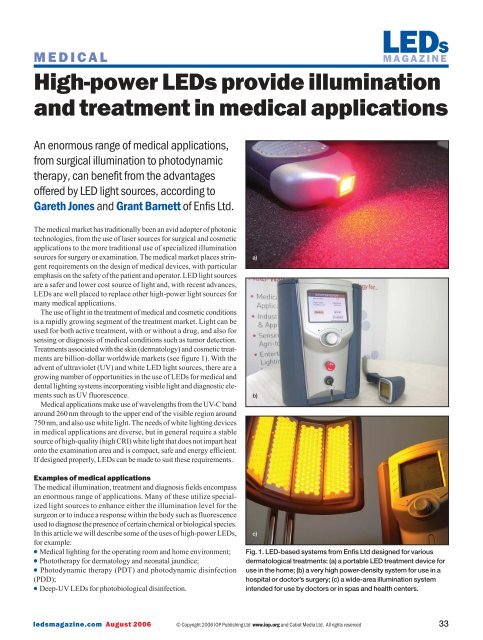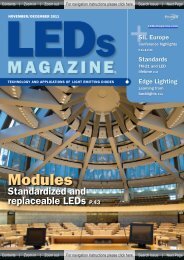LEDs Magazine Review - Beriled
LEDs Magazine Review - Beriled
LEDs Magazine Review - Beriled
- No tags were found...
You also want an ePaper? Increase the reach of your titles
YUMPU automatically turns print PDFs into web optimized ePapers that Google loves.
MEDICALHigh-power <strong>LEDs</strong> provide illuminationand treatment in medical applicationsAn enormous range of medical applications,from surgical illumination to photodynamictherapy, can benefit from the advantagesoffered by LED light sources, according toGareth Jones and Grant Barnett of Enfis Ltd.LEDSMAGAZINEThe medical market has traditionally been an avid adopter of photonictechnologies, from the use of laser sources for surgical and cosmeticapplications to the more traditional use of specialized illuminationsources for surgery or examination. The medical market places stringentrequirements on the design of medical devices, with particularemphasis on the safety of the patient and operator. LED light sourcesare a safer and lower cost source of light and, with recent advances,<strong>LEDs</strong> are well placed to replace other high-power light sources formany medical applications.The use of light in the treatment of medical and cosmetic conditionsis a rapidly growing segment of the treatment market. Light can beused for both active treatment, with or without a drug, and also forsensing or diagnosis of medical conditions such as tumor detection.Treatments associated with the skin (dermatology) and cosmetic treatmentsare billion-dollar worldwide markets (see figure 1). With theadvent of ultraviolet (UV) and white LED light sources, there are agrowing number of opportunities in the use of <strong>LEDs</strong> for medical anddental lighting systems incorporating visible light and diagnostic elementssuch as UV fluorescence.Medical applications make use of wavelengths from the UV-C bandaround 260 nm through to the upper end of the visible region around750 nm, and also use white light. The needs of white lighting devicesin medical applications are diverse, but in general require a stablesource of high-quality (high CRI) white light that does not impart heatonto the examination area and is compact, safe and energy efficient.If designed properly, <strong>LEDs</strong> can be made to suit these requirements.Examples of medical applicationsThe medical illumination, treatment and diagnosis fields encompassan enormous range of applications. Many of these utilize specializedlight sources to enhance either the illumination level for thesurgeon or to induce a response within the body such as fluorescenceused to diagnose the presence of certain chemical or biological species.In this article we will describe some of the uses of high-power <strong>LEDs</strong>,for example:● Medical lighting for the operating room and home environment;● Phototherapy for dermatology and neonatal jaundice;● Photodynamic therapy (PDT) and photodynamic disinfection(PDD);● Deep-UV <strong>LEDs</strong> for photobiological disinfection.a)b)c)Fig. 1. LED-based systems from Enfis Ltd designed for variousdermatological treatments: (a) a portable LED treatment device foruse in the home; (b) a very high power-density system for use in ahospital or doctor’s surgery; (c) a wide-area illumination systemintended for use by doctors or in spas and health centers.ledsmagazine.com August 2006© Copyright 2006 IOP Publishing Ltd www.iop.org and Cabot Media Ltd. All rights reserved33
















